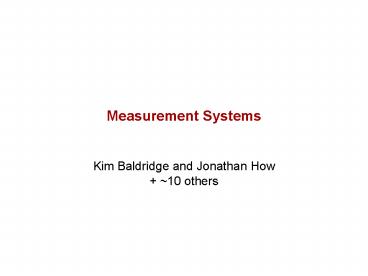Measurement Systems - PowerPoint PPT Presentation
1 / 7
Title: Measurement Systems
1
Measurement Systems
- Kim Baldridge and Jonathan How 10 others
2
Measurement system within DDDAS Framework
Data Reduction
Instruments Sensors Databases
Feature ExtractionQuality Assessment Re-Format
Data
AssimilationValidation
Data Refinement
Data Integrity
The key component of the measurement system
which is a key component of DDDAS
Update
Data Measurement Steering
Predictability
Model
New Knowledge
Update
- Application / system software / algorithms impact
all aspects of this process - Issue Need to be able to accurately predict the
value of the measurements to perform the
measurement redeployment
3
Data Measurement Redeployment
- Process depends on sensor types available and the
application - Different types of sensor selection choices
- Static e.g., change sensor properties
- Examples
- Many distributed structural sensors
- Mobile e.g., change where measurements are taken
and on what length/ time-scales - Mobile sensor networks (communication) UAVs,
UUVs, Bouys - Distributed on-demand measurements, information
consensus - Self-organizing, redeployment
- Examples
- Aircraft flight plans loosely coupled to weather
modeling ? tighter coupling - River environmental sensing (passive deployment)
? active deployment - Adaptive e.g., change what types of measurements
are taken - Focus analysis of a camera image to different
regions - Adaptive optics
- Examples
- Real time 2D MRI slice ? 3D
- Fixed frequency spectrometers ? different
frequency ranges - Fixed grid ? Adaptive grid (B. Plale)
4
Redeployment Issues
- When data is collected, to sense or not to sense,
what to sense? - How will we use the models/data to make these
decisions? - For some applications, it is not obvious what to
measure - Can be a very indirect process for some complex
systems (biological) - Need a good model of what the sensor does and how
it interacts with the system to assess the value
of the measurement ? can we even write yh(x,t) ? - How can we use the data to directly improve this
process. - What algorithms are used? (nonlinear estimation)
- For what reason what is the objective / goal of
the sensing? - To obtain new knowledge, for closed-loop control,
to improve the model quality, to reduce the
uncertainty in the loop, or to improve the system
observability - Optimization
- What are the cost/benefit of deployments - Use of
finite resources (battery) - QOS of the sensor
network (high BW over short periods or low BW
over long periods) - When - How dynamic is the system?
- Where to measure?
- Measurement allocation process analyze the
utility of moving sensors to specific locations - Danger (e.g., Fire tracking)
5
Issues 2 Limiting/Enabling Factors
- Cost of measuring system
- Cost of device/static vs mobile
- Power
- e.g., battery life reliability in extreme
conditionsbandwidth of data collection
limitations - Uniformity of Interface to measurement process
- protocols standards
Middlewarefederates dataacross
disciplinaryvocabularies
Portals, Domain Specific APIsprovide accessto
data
DATA
Models
Observation
6
Issues 2 Limiting/Enabling Factors
- Interdisciplinary nature from theory to expt -
education/training need for more specialized
education opportunities at the interface of
disciplines - Improvements in measurement systems
- Power, e.g., battery life reliability in extreme
conditions - collection bandwidth
- Design/robustness of expt systems
- Improvements in means/methods of collecting data
- Focus in regions of relevancy
- Controlling sampling
- Assess the validity of data
- Error bars time stamps quantification of
uncertainty - Uniformity of data across instruments/sensors of
the same type. - Sensitivity/quality of same data as measured
across different types of instruments/sensors/data
bases - Failure indicators
- Capacity to collect percentage of noise
7
Issues 2 Limiting/Enabling Factors
- Features in data
- When to include data as rare events (for
training) and - when to assume it is a fault of the measuring
device - How to recover from feature events
- Decision as part of the measurement system
- New component offered by DDDAS
- Feedback loop is the decision/prediction of what
data is needed to improve model - Need for more data
- Where to collect
- Error correction
- Quantification of uncertainty
- Quality decision as a function of application
type - fast/cheap/lower quality
- slow/expensive/higher quality































